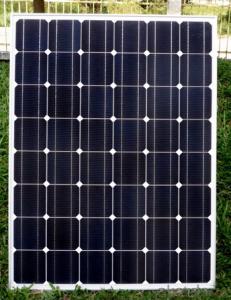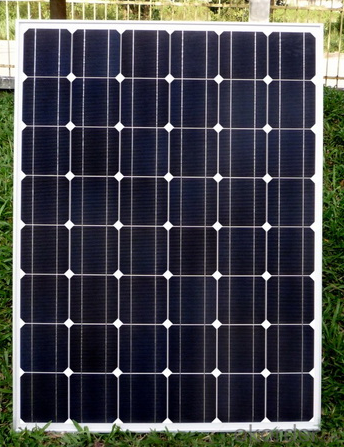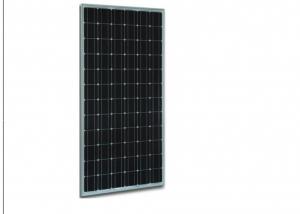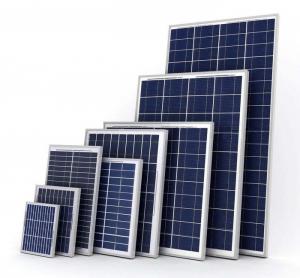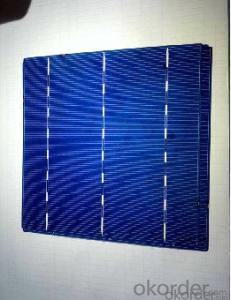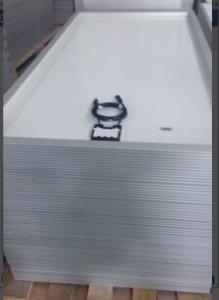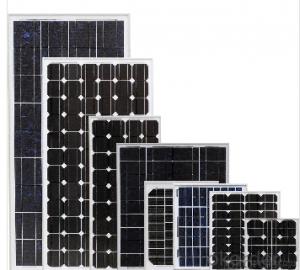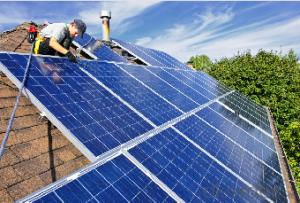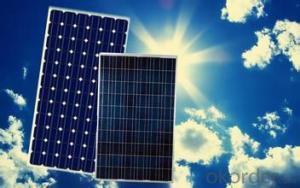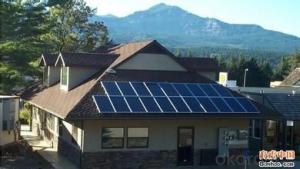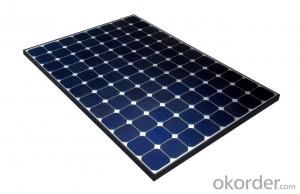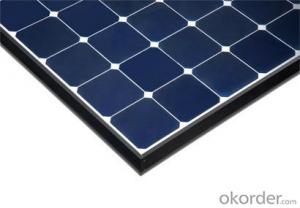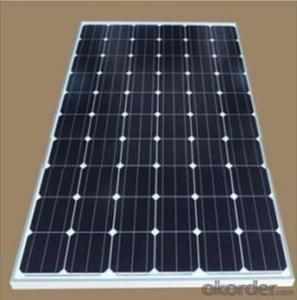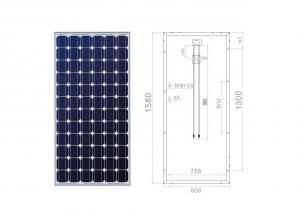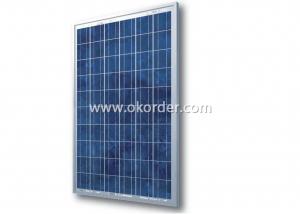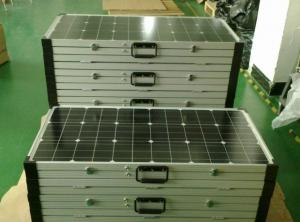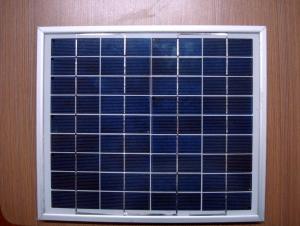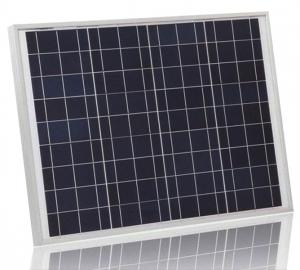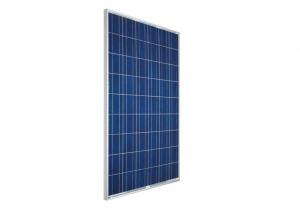100 Watt CNBM Polycrystalline Silicon Solar Panels for Home Use
- Loading Port:
- Tianjin
- Payment Terms:
- TT OR LC
- Min Order Qty:
- 100 watt
- Supply Capability:
- 1000 watt/month
OKorder Service Pledge
OKorder Financial Service
You Might Also Like
Specification
100W CNBM Polycrystalline Silicon Panel for Home Using
Production description
Most solar modules are currently produced from crystalline silicon (c-Si) solar cells made of multicrystalline andmonocrystalline silicon. In 2013, crystalline silicon accounted for more than 90 percent of worldwide PV production, while the rest of the overall market is made up of thin-film technologies using cadmium telluride, CIGS and amorphous silicon[7]Emerging, third generation solar technologies use advanced thin-film cells. They produce a relatively high-efficiency conversion for the low cost compared to other solar technologies. Also, high-cost, high-efficiency, and close-packed rectangular multi-junction (MJ) cells are preferably used in solar panels on spacecraft, as they offer the highest ratio of generated power per kilogram lifted into space. MJ-cells are compound semiconductors and made of gallium arsenide (GaAs) and other semiconductor materials. Another emerging PV technology using MJ-cells is concentrator photovoltaics (CPV).

Feature
Long-term stability,reliability and performance
Low breakage rate
Color uniformaity
Physical characteristic
1. Rigorous quality control meets the highest international standards.
2. High-transmissivity low-iron tempered glass, strong aluminium frame.
3. Using UV-resistant silicon.
4. IS09001/14001/CE/TUV/UL
- Q: Can solar panels be installed on military installations?
- Yes, solar panels can be installed on military installations. In fact, many military bases around the world have started incorporating solar energy systems to reduce their dependence on traditional sources of energy and enhance their sustainability efforts. Solar panels not only help to decrease the environmental impact but also provide a reliable and secure source of electricity, making them an ideal choice for military installations.
- Q: Can solar panels be used for air conditioning?
- Yes, solar panels can be used for air conditioning. Solar panels generate electricity from sunlight, which can be used to power air conditioning units. By using solar energy, homeowners and businesses can reduce their reliance on traditional electricity sources and decrease their carbon footprint. However, the efficiency and effectiveness of using solar panels for air conditioning may vary depending on factors such as the size of the solar system, location, and energy requirements of the air conditioning unit.
- Q: Online stores selling solar photo-voltaic generation kits gives specs indicating the power generation capability of the system. For example, Solar World Grid-Tie Solar Electric System with 245W Panels PV Powered PVP2000 Inverter, .2 to 2.4 kW. This seems to indicate that the system can generate .2 to 2.4 kW. Is that per day? Per month? I'm trying to calculate the return on investment, but can't because I don't know how much power a system such as this will generate in a month.
- As Ed said, that .2 kW is an instantaneous rating in bright sun. The way to do this right is to consult the maps here rredc.nrel /solar/old_data/nsr... to find the number of equivalent sun-hours your location gets per day. Select, Average, Annual, Flat plate tilted south at latitude. A map will come up. For northern California, it shows 5 equivalent sun hours per day, for example. If the system is .2 kW, then .2 x 5 = 6.0 kWh of energy the system will generate per day, on average. That takes into account cloudy days, short winter days, long summer days, everything. The 2.4 kW system would give double that, obviously. But that's an example, based on a specific location. Phoenix would do better, Seattle would do worse.
- Q: Can solar panels be installed on a warehouse or distribution center?
- Yes, solar panels can be installed on a warehouse or distribution center. In fact, these large flat rooftops are ideal locations for solar panel installations due to their ample space and reduced shading. By harnessing solar energy, warehouses and distribution centers can significantly reduce their dependence on traditional grid electricity and lower their carbon footprint.
- Q: I'm doing a project for school where I will buy a solar panel and utilize/improve the power output of the panel. I want the panel to have an improved amount of energy output compared to the original. My budget for the solar panel itself is ~$00. Anything else that will be needed is covered.Also, I will be comparing the power by lighting a light bulb and checking to see the output energy of the panel.Where or how should I approach this project?What are the parts of the solar panel that I will need to buy?What factors could I change/improve to improve the overall energy output?What are the things (other than the panel) that I will need to buy?How can I attach a light bulb to the solar panel?
- when you're in Malaysia, i'm no longer effective why you desire a heater, except perhaps a water heater. For that, use a photo voltaic heater right away. For the electrical energy, the most value-efficient thanks to do that's to stay linked to the grid, and offset your bill with photo voltaic. That way, you do not favor to oversize the photo voltaic for contingencies. there'll be compromise on your way of existence, each and every thing that plugs into the wall today will nevertheless plug into the wall and artwork advantageous.
- Q: I hooked up a 2V solar panel to a small relay. The relay switches at 9V. When I have light shining on the panel it puts out aorund 3-4V, but when I hook it up directly to the relay it drops to V and doesn't switch the relay. Why? and How do I fix it?-2V Mono-Crystalline Solar Panel -JWD 7 4 reed relay
- I suspect the voltage is OK but the amount of current the solar cell is capable of delivering is less than the relay coil needs to operate. The current the relay tries to draw overloads the PV. You need to add additional PVs in parallel to operated the relay coil. An alternative is to use a low current draw relay coil or use a transistor switch. Hope this helps, NewtonLaw
- Q: Tell me complete installation I have one 50Ah battery two 80 watts solar panels about 30 meter DC wire i charge ontroller and 000watt inverter. How i hook two solar panels to charge controller to battery then inverter?
- Wires from panels go to controller input terminals. Controller DC battery terminals to battery so that the controller will protect batteries and split power as required by demand to the inverter. Output DC on controller to inverter. Output AC or outlets on the inverter to AC appliances. One thousand watts is not very much capacity. It will keep your computer running and a lamp to read by. It won't run major appliances. A hair dryer is typically 500 watts and could not be run by this system.
- Q: I am going to be building green in the next couple of years and i need an idea of how many solar panels i need in addition to a wind turbine to sufficiently handle a workshop, house, green house, etc. and what the approximate cost will be.
- I think Brian's answer was perfect for the US, but in the UK, with very high gas and oil prices, we would also look at hydrogen production from the wind turbine instead of a battery store, where excess capacity could be used to heat the house or potentially act as a car fuel. Alternatively we would look to selling back excess electricity to the grid.
- Q: How do solar panels affect the overall carbon footprint of a building?
- Solar panels can significantly reduce the overall carbon footprint of a building. By harnessing clean and renewable energy from the sun, solar panels eliminate or greatly reduce the need for traditional fossil fuel-based electricity generation. This means lower emissions of greenhouse gases like carbon dioxide, which are major contributors to climate change. The use of solar panels helps to transition buildings towards a more sustainable and eco-friendly energy source, effectively reducing their carbon footprint.
- Q: How do solar panels and heaters work?
- Solar panels are solar powered- they use energy produced from the sun. While heaters- receive already produced energy to produce heat... hope this helps!
Send your message to us
100 Watt CNBM Polycrystalline Silicon Solar Panels for Home Use
- Loading Port:
- Tianjin
- Payment Terms:
- TT OR LC
- Min Order Qty:
- 100 watt
- Supply Capability:
- 1000 watt/month
OKorder Service Pledge
OKorder Financial Service
Similar products
Hot products
Hot Searches
Related keywords
